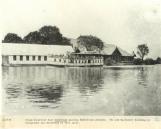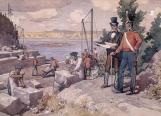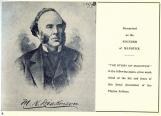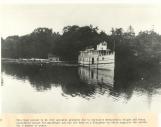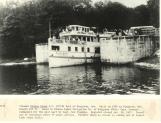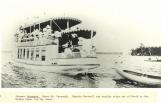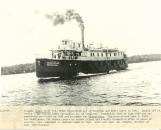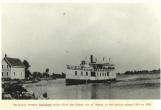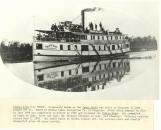2
The Damming of the Channel and the Creation of a Mill SiteA control dam had preciously been built at the Long Island Locks. Unfortunately, due to the harsh winters and the spring runoff, the dam failed in the 1830's. Therefore, in 1858, a new dam was constructed further upstream on the Rideau River. Moss Kent Dickinson and Joseph Merrill Currier leased the water rights from the federal government in 1859 for fifty dollars a year, as well as thirty acres of the surrounding land at this new dam site.
Dickinson dreamed of starting his own little village and he knew that the dam had enough water power to operate a mill, perhaps even many mills. The site was perfect. He had water power, land available for future growth, land for his employees to live on, he was close enough to Ottawa to transfer the goods his mills would produce and he had the waterway and ships to accomplish this.
4
Dickinson's Development of a Town Site and the Founding of ManotickIn 1862, Dickinson developed a plan for his village, including a name. He chose Manotick, an Ojibway word meaning "Island in the River." The plans were completed in 1862 and registered with the County of Carleton.
The area around the dam in Manotick had very little settlement and the land was available. Dickinson decided to buy thirty acres. He chose to build a sawmill and a modern gristmill powered by turbines. His holdings were in a large circle around the mills on either side of the back channel. His home across the street from his gristmill served as the Moss Kent Dickinson's General Trading and Manufacturing Depot and Farmers Exchange, housing the main offices for his busy mills. The Carriage House next door to his home allowed farmers to tie their horses while visiting his milling enterprise.
5
The Role of Mills in the Settlement of Eastern OntarioMills played a crucial role in the settlement of Eastern Ontario, Ottawa and Manotick in particular. Mills were often the first non-domestic buildings that were erected in a newly settled area. They were the gathering place and the main focal point for village activities. Through the exporting of its goods, mills boosted the economy of a region. It was much cheaper to produce the goods yourself rather then importing them.
Canada was becoming more self-sufficient and Ottawa and Manotick were growing rapidly. Dickinson knew there would be a need for wool, flour, and wood from his mills. Job opportunities for the men of the area were in abundance. Manotick " participated" in four townships, since it is located exactly at the junction of four of the old division lines: North Gower, Nepean, Osgoode and Glocester. As a result, the village of Manotick became the most flourishing and prosperous village in the County of Carleton.
11
The steamer Wanikiwan by the exhibition grounds, Ottawa, Ontarioearly 1900's
Rideau Canal, Ontario, Canada
